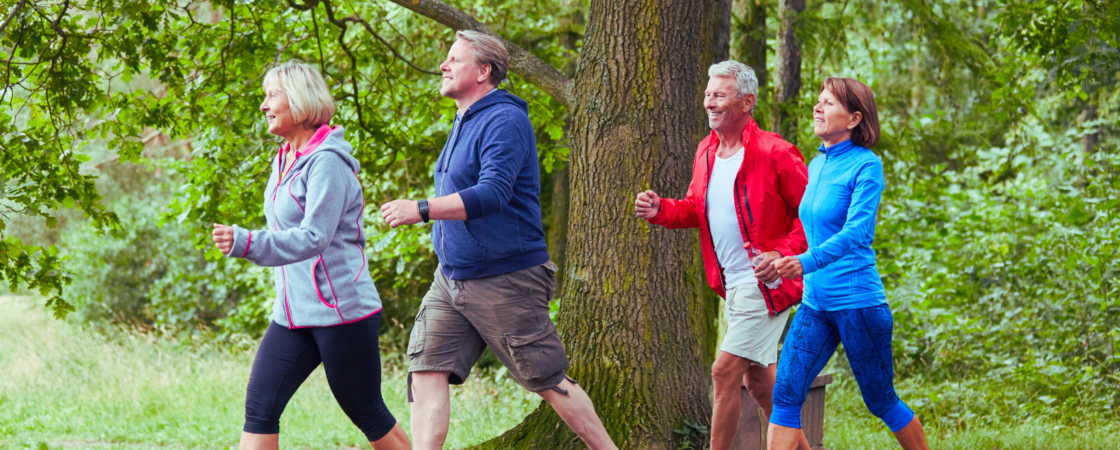Walking is a foundational exercise that supports our well-being, yet recent research emphasizes a specific benefit of walking faster: a longer life expectancy. In this article, we explore the science-backed reasons why increasing your walking pace could contribute to a longer life, discuss the ideal target speed, and offer tips for incorporating brisk walking into daily routines for maximum health benefits. Let’s break down the components of fast walking and its effect on longevity to understand how a simple shift in pace can make a profound impact on health.
The Science Behind Walking and Longevity
Research has consistently shown that physical activity is crucial for maintaining good health and extending life expectancy. Walking, in particular, is accessible to most people and can be easily incorporated into daily routines. However, the pace at which you walk can make a significant difference.
A study published in the Journal of the American College of Cardiology found that walking at a faster pace was associated with a reduced risk of death, regardless of the number of steps taken per day. This finding aligns with the U.S. Centers for Disease Control and Prevention’s recommendation of 150 minutes of moderate-intensity activity each week for most adults.
Here are some additional studies and research findings on the impact of walking pace on health and longevity:
- Self-Rated Walking Pace and Mortality:
- A study published in the British Journal of Sports Medicine analyzed data from over 50,000 walkers across 11 population cohorts in the UK. It found that walking at an average or brisk pace was associated with a reduced risk of all-cause mortality by 20% and 24%, respectively, compared to walking at a slow pace.
- Outdoor Walking Speeds of Healthy Adults:
- A systematic review and meta-analysis published in Sports Medicine examined outdoor walking speeds of healthy adults. It found that walking at a usual pace (1.31 m/s) and a fast pace (1.72 m/s) met or exceeded public health guidelines for moderate-to-vigorous physical activity.
- University of Sydney Research:
- Research led by the University of Sydney indicated that walking at an average pace reduced the risk of all-cause mortality by 20%, while walking at a brisk or fast pace reduced the risk by 24%.
- Harvard T.H. Chan School of Public Health:
- The Nutrition Source at Harvard highlights that faster walking paces are linked to greater health benefits, including a reduced risk of cardiovascular disease and early death.
- University of Leicester Study on Biological Ageing:
- Researchers from the University of Leicester found that a faster walking pace was associated with longer telomeres, which are indicators of biological ageing. This suggests that brisk walking may help slow the ageing process.
Why Walking Pace Matters for Longevity
- The Link Between Speed and Lifespan
Studies have shown that the pace at which people walk correlates with their longevity. Faster walkers tend to live longer than their slower counterparts, even when adjusting for age, gender, and other health variables. Brisk walking, defined as a pace between 3-4.5 miles per hour (4.8-7.2 km/h), can significantly improve cardiovascular health and respiratory function, which are essential to maintaining a long, healthy life.
- How a Faster Pace Affects the Body
Increasing walking speed enhances cardiovascular fitness, strengthens muscles, and increases lung capacity. Fast walking stimulates blood circulation, supplying more oxygen to muscles and organs, reducing strain on the heart, and improving overall energy levels. Furthermore, brisk walking can promote improved mood, better sleep, and stronger immune function.
- Optimal Walking Pace for Longevity
Experts suggest aiming for a pace of around 100 steps per minute, which equates to moderate physical activity. This pace is not only beneficial for cardiovascular health but also helps in reducing the risk of various diseases. For older adults, walking at this pace for 30 minutes a day, five days a week, meets the weekly requirements for moderate exercise.
Health Benefits of Walking Faster
- Cardiovascular Health
Walking faster forces the heart to pump more efficiently, improving circulation and reducing blood pressure. Regular brisk walking is linked to a lower risk of heart disease, stroke, and other cardiovascular conditions. By maintaining a faster pace, we can improve heart health, boost HDL (good) cholesterol, and reduce LDL (bad) cholesterol.
- Weight Management and Metabolism
Brisk walking is a low-impact exercise that helps burn more calories and can improve metabolism over time. Walking at a faster pace allows for more significant calorie burn compared to slower walking, supporting weight management goals and decreasing the risk of obesity and its related diseases.
- Improved Mental Health
Physical activity, especially at moderate to vigorous intensity levels, can help reduce symptoms of anxiety and depression. Fast walking stimulates the release of endorphins, often referred to as “feel-good” hormones, which play a key role in mood stabilization and stress reduction.
- Bone and Joint Health
Walking strengthens bones and improves joint flexibility, reducing the risk of osteoporosis and arthritis.
- Longevity
Studies have shown that walking faster can reduce the risk of all-cause mortality by up to 24%.
Ideal Walking Pace for Longevity
- Finding the Target Speed
While an ideal walking pace can vary based on age, health, and fitness level, research indicates that a pace between 3 to 4 miles per hour is optimal for longevity benefits. For a more personalized approach, the “talk test” can help gauge whether one is walking briskly enough: at the target pace, you should be able to carry on a conversation but not sing comfortably.
- Tailoring Pace by Age and Health Condition
Walking intensity can vary depending on individual health conditions. For older adults or those with certain health conditions, a moderate increase in pace rather than a full sprint may be appropriate. Consulting with a healthcare professional can help tailor a walking routine that maximizes benefits without risking injury.
Tips for Achieving and Maintaining a Faster Walking Pace
- Focus on Posture
Maintaining a strong posture can help improve speed and efficiency. Stand tall with your head up, shoulders relaxed, and swing your arms naturally at your sides. Good posture reduces strain and allows for greater mobility while walking.
- Use Interval Training
Interval training, which involves alternating between slower and faster walking, can help build endurance and increase your overall walking pace over time. Start with a moderate pace, then walk briskly for 30 seconds to a minute before returning to the initial pace.
- Invest in Comfortable Footwear
Supportive, cushioned shoes can make a difference in both comfort and speed. Well-fitted shoes with good arch support and shock absorption are essential for avoiding injuries and improving stride efficiency.
- Set Realistic Goals
Start by setting achievable goals. If you’re new to walking, begin with a comfortable pace and gradually increase your speed.
- Use a Pedometer or Fitness Tracker
These devices can help you monitor your steps and pace, ensuring you stay on track with your fitness goals.
- Choose the Right Footwear
Invest in a good pair of walking shoes that provide support and comfort.
- Warm-Up and Cool Down:
Always start with a warm-up to prepare your muscles and end with a cool-down to prevent injuries.
- Incorporate Interval Training:
Alternate between walking at a moderate pace and a faster pace to build endurance and strength.
Tips for Maintaining a Faster Walking Pace
- Posture: Maintain an upright posture with your shoulders back and relaxed. Keep your head up and look forward.
- Arm Movement: Swing your arms naturally with each step to help propel you forward.
- Stride Length: Take shorter, quicker steps rather than long strides to maintain a faster pace.
- Breathing: Practice deep, rhythmic breathing to ensure your muscles get enough oxygen.
Incorporating Brisk Walking into Daily Life
- Adding Walking Intervals Throughout the Day
For individuals with a busy schedule, incorporating short walks throughout the day can make it easier to reach longevity-boosting walking speeds. Try a 5-10 minute brisk walk after meals or take stairs instead of elevators.
- Walking with Friends or Pets
Social walking is not only enjoyable but can also help maintain motivation. Walking with friends, family, or pets adds accountability and makes it more likely to maintain a consistent, faster pace over time.
Monitoring Progress for Long-Term Benefits
- Setting Realistic Goals and Tracking Performance
Establish clear, attainable goals to stay motivated. Use fitness tracking apps or wearable devices to monitor your steps, distance, and pace to measure progress. Consistently tracking improvements can provide insights into how brisk walking is impacting your overall fitness and longevity.
- Regular Health Checkups
Routine health screenings can help identify improvements in cardiovascular health, respiratory function, and other areas impacted by faster walking. Consulting with a healthcare provider on these metrics can further validate the longevity benefits of a faster walking pace.
Potential Risks and How to Avoid Injury
- Avoiding Overexertion
Pushing too hard can lead to muscle strain or fatigue, especially for beginners. Gradually increasing pace and duration can prevent injuries and make it easier to sustain a brisk walking habit. Stretching before and after a walk can also reduce injury risk.
- Managing Health Conditions
For those with chronic conditions or limited mobility, it’s essential to ease into faster walking. Consulting a healthcare provider for tailored guidance can ensure a safe, effective walking routine.
Conclusion
Increasing walking pace to a brisk level can be a highly effective way to enhance longevity. With benefits that span cardiovascular health, weight management, and mental well-being, a faster walking pace holds immense potential for improving quality of life. By incorporating even short bursts of brisk walking into daily routines, maintaining proper form, and tracking progress, individuals can gain significant, long-term health benefits. Embracing this simple yet powerful lifestyle change may be a valuable key to living longer, healthier lives.
Frequently Asked Questions
How fast should I walk to gain health benefits?
Experts recommend aiming for a pace of around 100 steps per minute, which is considered moderate-intensity activity. This pace is beneficial for cardiovascular health and can help reduce the risk of various diseases. For most people, this translates to walking briskly enough to increase your heart rate and make you breathe harder, but still being able to hold a conversation.
How much faster walking do I need to do each week?
The U.S. Centers for Disease Control and Prevention (CDC) recommends at least 150 minutes of moderate-intensity aerobic activity, such as brisk walking, per week. This can be broken down into 30 minutes a day, five days a week. If you prefer more vigorous activity, 75 minutes per week is sufficient.
What are the specific health benefits of walking faster?
Walking at a faster pace can improve cardiovascular health, aid in weight management, enhance mental health by reducing stress and anxiety, strengthen bones and joints, and potentially increase longevity. Studies have shown that brisk walking can reduce the risk of all-cause mortality by up to 24%.
Can walking faster help with weight loss?
Yes, walking faster can help with weight loss as it burns more calories compared to walking at a slower pace. It also helps in maintaining a healthy metabolism. Incorporating brisk walking into your routine, along with a balanced diet, can be an effective strategy for weight management.
How can I start walking faster if I’m not used to it?
Start by setting realistic goals and gradually increasing your pace. Use a pedometer or fitness tracker to monitor your steps and pace. Ensure you have the right footwear for support and comfort. Begin with a warm-up and end with a cool-down to prevent injuries. Incorporate interval training by alternating between moderate and faster paces to build endurance and strength.
Is it possible to be allergic to your Christmas tree?
I tend to become sneezy and stuffy during the holiday season. Is my Christmas tree at fault? The holiday season can bring joy and laughter, but it can also lead
Can chilly weather cause illness? Your grandmother wasn’t completely mistaken.
Grandma’s advice about the dangers of walking barefoot on a cold floor or stepping outside with wet hair holds some validity.
Biden aims for Medicare and Medicaid to include expensive weight-loss medications like Wegovy in their coverage.
The Biden administration aims to broaden access to anti-obesity medications for millions of individuals on Medicare and Medicaid.
5 Ways R.F.K. Jr. Could Undermine Lifesaving Childhood Vaccines
If he is confirmed as H.H.S. secretary, the longtime vaccine critic would be in a position to change the government’s immunization recommendations and delay the development of new vaccines.. For
Pancreatic Cancer Surge May Be Less Worrisome Than It Seemed
A rise in the disease in younger people was not followed by an increase in deaths, a study found, and might be a sign of overdiagnosis.. One of the first
POTS and Sjögren’s syndrome: Autoimmune conditions that impact millions of people in the United States.
Millions of Americans, primarily women, endure the symptoms of autoimmune diseases, some of which can be chronic and potentially life-threatening.




